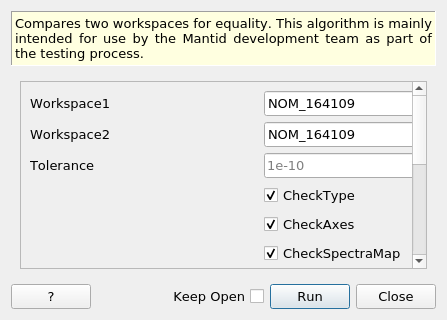\(\renewcommand\AA{\unicode{x212B}}\)
CompareWorkspaces v1¶

CompareWorkspaces dialog.¶
Summary¶
Compares two workspaces for equality. This algorithm is mainly intended for use by the Mantid development team as part of the testing process.
See Also¶
Properties¶
Name |
Direction |
Type |
Default |
Description |
|---|---|---|---|---|
Workspace1 |
Input |
Mandatory |
The name of the first input workspace. |
|
Workspace2 |
Input |
Mandatory |
The name of the second input workspace. |
|
Tolerance |
Input |
number |
1e-10 |
The maximum amount by which values may differ between the workspaces. |
CheckType |
Input |
boolean |
True |
Whether to check that the data types (Workspace2D vs EventWorkspace) match. |
CheckAxes |
Input |
boolean |
True |
Whether to check that the axes match. |
CheckSpectraMap |
Input |
boolean |
True |
Whether to check that the spectra-detector maps match. |
CheckInstrument |
Input |
boolean |
True |
Whether to check that the instruments match. |
CheckMasking |
Input |
boolean |
True |
Whether to check that the bin masking matches. |
CheckSample |
Input |
boolean |
False |
Whether to check that the sample (e.g. logs). |
ToleranceRelErr |
Input |
boolean |
False |
Treat tolerance as relative error rather then the absolute error. This is only applicable to Matrix workspaces. |
CheckAllData |
Input |
boolean |
False |
Usually checking data ends when first mismatch occurs. This forces algorithm to check all data and print mismatch to the debug log. Very often such logs are huge so making it true should be the last option. |
NumberMismatchedSpectraToPrint |
Input |
number |
1 |
Number of mismatched spectra from lowest to be listed. |
DetailedPrintIndex |
Input |
number |
Optional |
Mismatched spectra that will be printed out in details. |
Result |
Output |
boolean |
||
Messages |
Output |
compare_msgs |
TableWorkspace containing messages about any mismatches detected |
Description¶
Compares two workspaces for equality. This algorithm is mainly intended for use by Mantid developers as part of the testing process.
The data values (X,Y and error) are always checked. The algorithm can also optionally check the axes (this includes the units), the spectra-detector map, the instrument (the name and parameter map) and any bin masking.
In the case of EventWorkspaces, they are checked to hold identical event lists. Comparisons between an EventList and a Workspace2D always fail.
This algorithm has two outputs: A boolean “Result” that indicates whether the workspaces matched (true) or not (false), and a TableWorkspace property named “Messages” (workspace name defaults to “compare_msgs”) with three columns. The first column contains messages about any mismatches that were detected. The second and third columns are the names of the workspaces that were being compared when the mismatch message was issues. If all the input workspaces matched, the message workspace will be empty.
Please note that details about the comparisons will be only available when the log level is set to debug.
Checking option CheckInstrument will enable the following comparisons between the instruments embedded in each of the two workspaces:
instrument name
positions and rotations of detectors
mask of detectors
position of the source and sample
instrument parameters
Usage¶
Example - Check that two workspaces are equal to one another:
dataX = [0,1,2,3,4,5,6,7,8,9]
dataY = [1,1,1,1,1,1,1,1,1]
ws1 = CreateWorkspace(dataX, dataY)
#create a copy of the workspace
ws2 = CloneWorkspace(ws1)
(result, messages) = CompareWorkspaces(ws1, ws2)
print("Result: {}".format(result))
print(messages.rowCount())
Output:
Result: True
0
Example - Check that two workspaces match within a certain tolerance:
import numpy as np
# Create a workspace with some simple data
dataX = range(0,20)
dataY1 = np.sin(dataX)
ws1 = CreateWorkspace(dataX, dataY1)
# Create a similar workspace, but with added noise
dataY2 = np.sin(dataX) + 0.1*np.random.random_sample(len(dataX))
ws2 = CreateWorkspace(dataX, dataY2)
(result, messages) = CompareWorkspaces(ws1, ws2) # Fails, they're not the same
print("Result: {}".format(result))
print("Displaying {} messages:".format(messages.rowCount()))
for row in messages:
print("'Message': '{Message}', 'Workspace 1': '{Workspace 1}', 'Workspace 2': '{Workspace 2}'".format(**row))
(result, messages) = CompareWorkspaces(ws1, ws2, Tolerance=0.1) # Passes, they're close enough
print("Result: {}".format(result))
print("Displaying {} messages:".format(messages.rowCount()))
for row in messages:
print("'Message': '{Message}', 'Workspace 1': '{Workspace 1}', 'Workspace 2': '{Workspace 2}'".format(**row))
Output:
Result: False
Displaying 1 messages:
'Message': 'Data mismatch', 'Workspace 1': 'ws1', 'Workspace 2': 'ws2'
Result: True
Displaying 0 messages:
Categories: AlgorithmIndex | Utility\Workspaces
Source¶
C++ header: CompareWorkspaces.h
C++ source: CompareWorkspaces.cpp
